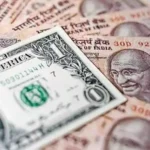
The Indian rupee faced significant pressure today, trading close to ₹88.77 per USD, near historical lows, as global market volatility and U.S. economic developments created strong dollar demand. Traders and market participants reported that the Reserve Bank of India actively intervened, selling dollars through state-owned banks to curb excessive volatility and maintain stability in the currency market.
The rupee’s weakness comes amid multiple external pressures: crude oil prices remain elevated, the U.S. dollar continues to strengthen against most currencies, and ongoing geopolitical tensions in Europe and Asia have heightened investor risk aversion. Additionally, uncertainty surrounding the U.S. government shutdown has further fueled safe-haven demand for the greenback.
Analysts note that domestic factors also played a role. Seasonal import demand, coupled with corporate dollar requirements for capital expenditure, contributed to increased dollar outflows. With India importing nearly 85% of its crude oil, sustained high oil prices exacerbate trade deficit pressures, further weighing on the rupee.
“Short-term volatility in the rupee is a natural response to global market dynamics,” said Suresh Mehta, currency strategist at ICICI Securities. “The RBI’s proactive intervention demonstrates the central bank’s commitment to curbing excessive swings, ensuring liquidity, and safeguarding macroeconomic stability.”
Market experts highlight that upcoming IPO inflows, such as Tata Capital and LG India, could provide temporary relief to the rupee. However, sustained appreciation or depreciation will depend on broader global financial conditions, including U.S. interest rate policies and emerging market capital flows.
The RBI’s role as a market stabilizer has become increasingly critical in a world of high-frequency trading and large-scale cross-border fund movements. By deploying both forward and spot interventions, the central bank aims to smooth out sharp currency movements while maintaining flexibility for monetary policy.
A weaker rupee, while concerning for import-dependent sectors, can benefit export-oriented industries. IT services, software exports, and certain manufacturing segments stand to gain from a more competitive pricing environment internationally. Conversely, sectors reliant on imported raw materials, such as electronics, petrochemicals, and automotive, may face higher costs, potentially translating into inflationary pressures.
Domestic investors are closely monitoring the currency trend alongside equity and bond markets, as volatility in the rupee often influences foreign portfolio inflows, interest rates, and stock valuations. Analysts recommend companies and investors adopt hedging strategies to mitigate forex risks in the near term.
Overall, while the rupee’s decline has raised concerns, the RBI’s swift intervention, combined with expected foreign capital inflows and macroeconomic fundamentals, is likely to prevent sustained depreciation. Policymakers continue to balance the dual goals of maintaining stability and allowing market-driven exchange rate flexibility.
